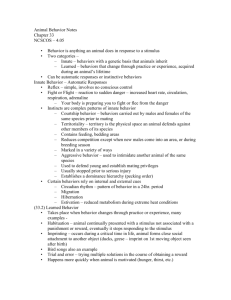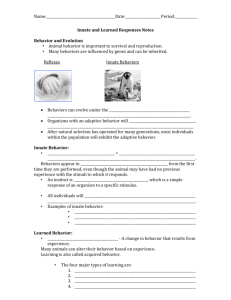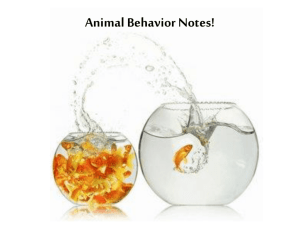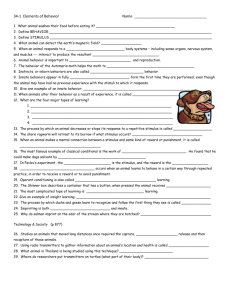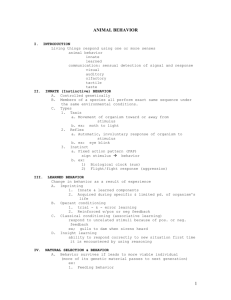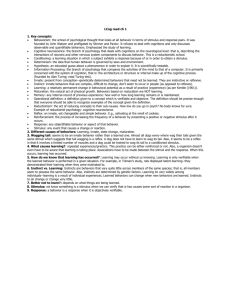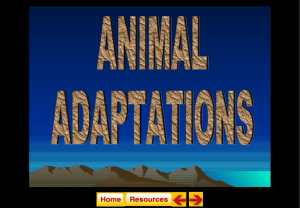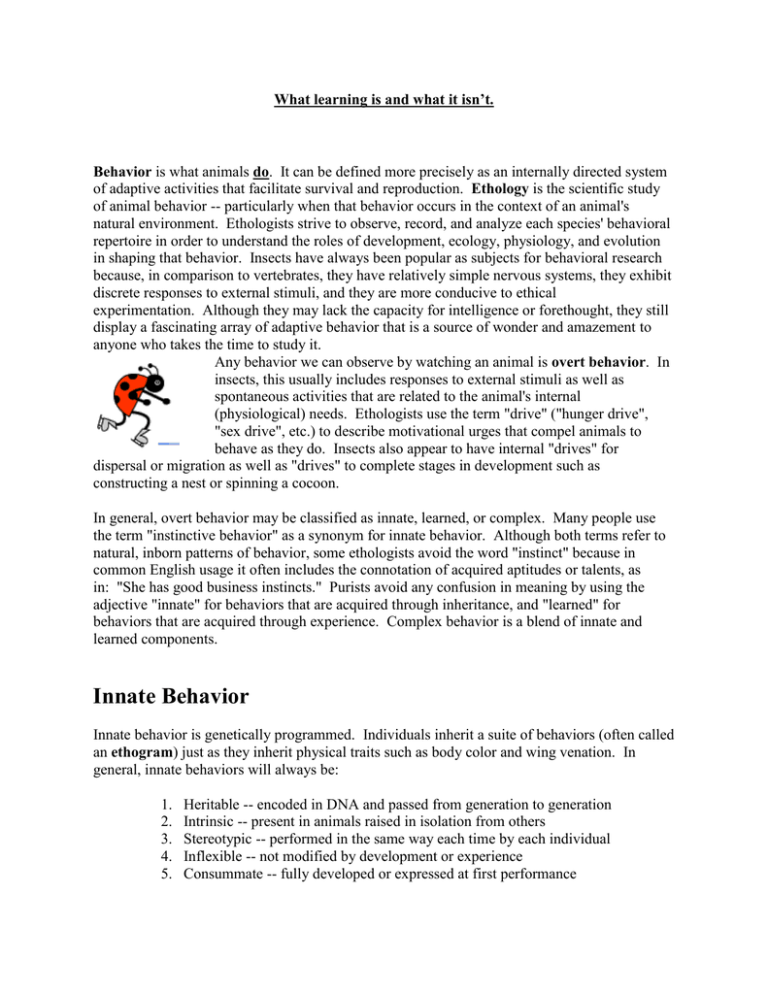
What learning is and what it isn’t.
Behavior is what animals do. It can be defined more precisely as an internally directed system
of adaptive activities that facilitate survival and reproduction. Ethology is the scientific study
of animal behavior -- particularly when that behavior occurs in the context of an animal's
natural environment. Ethologists strive to observe, record, and analyze each species' behavioral
repertoire in order to understand the roles of development, ecology, physiology, and evolution
in shaping that behavior. Insects have always been popular as subjects for behavioral research
because, in comparison to vertebrates, they have relatively simple nervous systems, they exhibit
discrete responses to external stimuli, and they are more conducive to ethical
experimentation. Although they may lack the capacity for intelligence or forethought, they still
display a fascinating array of adaptive behavior that is a source of wonder and amazement to
anyone who takes the time to study it.
Any behavior we can observe by watching an animal is overt behavior. In
insects, this usually includes responses to external stimuli as well as
spontaneous activities that are related to the animal's internal
(physiological) needs. Ethologists use the term "drive" ("hunger drive",
"sex drive", etc.) to describe motivational urges that compel animals to
behave as they do. Insects also appear to have internal "drives" for
dispersal or migration as well as "drives" to complete stages in development such as
constructing a nest or spinning a cocoon.
In general, overt behavior may be classified as innate, learned, or complex. Many people use
the term "instinctive behavior" as a synonym for innate behavior. Although both terms refer to
natural, inborn patterns of behavior, some ethologists avoid the word "instinct" because in
common English usage it often includes the connotation of acquired aptitudes or talents, as
in: "She has good business instincts." Purists avoid any confusion in meaning by using the
adjective "innate" for behaviors that are acquired through inheritance, and "learned" for
behaviors that are acquired through experience. Complex behavior is a blend of innate and
learned components.
Innate Behavior
Innate behavior is genetically programmed. Individuals inherit a suite of behaviors (often called
an ethogram) just as they inherit physical traits such as body color and wing venation. In
general, innate behaviors will always be:
1.
2.
3.
4.
5.
Heritable -- encoded in DNA and passed from generation to generation
Intrinsic -- present in animals raised in isolation from others
Stereotypic -- performed in the same way each time by each individual
Inflexible -- not modified by development or experience
Consummate -- fully developed or expressed at first performance
Since innate behavior is encoded in DNA, it is subject to genetic change through mutation,
recombination, and natural selection. Just like physical traits, innate behaviors are phylogenetic
adaptations that have an evolutionary history.
Comparative study of similar species often sheds light on
the selective pressures that drive evolutionary changes in
behavior. It may also help explain the origin of some very
unusual behavior. One species of dance fly, for example,
has a courtship ritual in which a male gives a ball of silk to a
female. She unravels the ball while he mates with her. By
itself, this curious behavior seems truely bizarre. But a
study of courtship in other dance flies reveals that males use
a nuptial gift as a way to divert a female's aggressive
behavior long enough for insemination to occur. In
"primitive" species, the nuptial gift is an item of prey that
the female consumes during copulation. In more
"advanced" species, males wrap the prey in silk, thus buying Dance flies mating. The female
a little extra time for copulation. In the species where males
is consuming a nuptial gift.
offer just a ball of silk, they are exploiting the female's
innate response to the stimulus of a nuptial gift. Just another example of "selfish genes" at
work!
Just because an insect's behavior is innate does not necessarily mean it is simple. Over time,
natural selection can lead to surprisingly intricate and sophisticated behavior such as the dance
language of honey bees or the courtship rituals of dance flies. These behaviors may appear
purposeful and intelligent, but they are merely the product of millions of years of genetic
refinement through natural selection.
In general, innate behaviors are viewed as "programmed" responses to external stimuli. They
usually fit into one of the following categories:
Reflex. The most basic unit of innate behavior is a simple reflex arc. This is a neural
pathway that may involve as few as two neurons: a
sensory neuron detects a stimulus and is linked with a
motor neuron that sets off a response in an effector cell
(such as a muscle or a gland cell). More commonly,
reflex arcs also include an association neuron spliced
between the sensory and motor neurons. The association
neuron also synapses with other neurons to relay information to the brain and other parts
of the body. Most insects have simple "startle" reflexes triggered by small disturbances
as well as more comprehensive "escape" reflexes triggered by larger disturbances.
Orientation Behaviors are coordinated movements (walking, flying, swimming, etc.)
that occur in response to an external stimulus. These behaviors have adaptive value for
survival by helping the insect locate (or avoid) the source of a stimulus. Orientation
behaviors can be viewed as elements in a neural hierarchy. The simplest behaviors
involve input from only a single sensory receptor whereas more advanced behaviors
require bilateral input from a pair of receptors.
Kinesis is a change in the speed of movement
(orthokinesis) or a change in the rate of turning
(klinokinesis) which is directly proportional to the
intensity of a stimulus. Input from only a single
sensory receptor is necessary. A kinesis is non-directed
orientation, that is, the animal exhibits a "random walk". The change in speed or
rate of turning increases the probability of locating the stimulus but does not
guarantee it.
Taxis is a movement directly toward (positive) or away from (negative) a
stimulus. A klinotaxis involves side-to-side motions of the head or body with
successive comparison of stimulus intensity as the animal moves forward. A
tropotaxis requires bilateral input from paired sensory receptors such that the
signal is equalized in both receptors. Stimulus intensity increases with
movement toward the source and decreases with movement away from the
source. A prefix may also be used to designate the type of stimulus involved (i.e.
phototaxis=light; geotaxis=gravity; thigmotaxis=contact with
other objects).
The dorsal light reaction is a special case (telotaxis) in which
movement occurs at a constant 90° angle to a light source. By
keeping the sun directly overhead, a flying or swimming
insect can insure that it travels parallel to the ground (or water
surface). A diving beetle, for example, can be fooled into
swimming upside down in an aquarium that is lit from
below. The dorsal light reaction also explains why moths tend to circle a street
lamp at night.
The light compass reaction is another special case (menotaxis) in which insects
(honey bees, for example) fly away from the nest site at a fixed angle (x°) to the
sun and return at the supplementary angle (180-x°) -- all without ever taking a
class in geometry!
Fixed Action Pattern (FAP) is a sequence of coordinated movements that are
performed together as a "unit" without interruption. Each FAP is triggered by a unique
stimulus variously known as a sign stimulus, a key stimulus, or a releaser. A praying
mantis striking at prey is a typical example. The releaser for this FAP is any movement
by a small (prey-sized) object within striking distance. Once initiated, the mantis cannot
change direction in mid-strike or abort the mission if the prey escapes.
Other common examples of FAPs
include courtship displays, hunting or
food gathering, nest-building activities,
and attack or escape movements. Unlike
simple reflexes, FAPs may involve a
whole-body response and often require a
threshold level of internal readiness (drive).
Case study:
Sand Wasps and FAPs
A fixed action pattern is rarely triggered by the "big picture" (Gestalt) in an
environmental context. Instead, the sign stimulus is usually a highly specific signal that
is consistently encountered at an appropriate time. Thus a male fruit fly will perform a
courtship display for a pheromone-impregnated cork even though the cork doesn't look,
taste, feel, or act like a female fruit fly. Sometimes, it is possible to find or create a
supernormal stimulus, essentially an exaggerated signal that produces a more vigorous
or more sustained response than a normal releaser. Apple growers, for example, hang
large red spheres coated with stick-um in their orchards to catch adults of the apple
maggot (Rhagoletis pomonella). The red spheres are a key stimulus for oviposition, and
to female apple maggots, size matters!
Performing one FAP may lead an insect to encounter the releaser for a second FAP and
that in turn may lead to the releaser for a third FAP, etc. This type of behavioral
cascade is common in insects. Niko Tinbergen, one of the "fathers" of modern
ethology, demonstrated that hunting behavior in a predatory wasp proceeds through a
stepwise series of three FAPs. The first releaser is visual: movement of a prey-sized
object triggers down-wind pursuit of the prey. At that point, prey odor is a releaser that
triggers catching behavior. Finally, tactile cues from the prey release stinging and egg
laying behavior.
When a fixed action pattern fulfills or satisfies a physiological drive, it may be known as
a consummatory act. Taking a blood meal, for example, satisfies a mosquito's hunger
drive. Any behavior that increases an individual's probability of encountering the
releaser for a consummatory act is often called an appetative behavior. Thus, chirping
by a cricket may be regarded as an appetative behavior because it increases the chances
of finding a mate and satisfying the sex drive.
Learned Behavior
Learning can be defined as a persistent change in behavior that occurs as a result of
experience. Since a newborn nymph or larva has no prior experience, its first behaviors will be
entirely innate. Each individual starts life with a "clean slate": it acquires new skills and
knowledge through trial and error, observation of other individuals, or memory of past
events. In general, learned behaviors will always be:
1.
2.
3.
4.
Nonheritable -- acquired only through observation or experience
Extrinsic -- absent in animals raised in isolation from others
Permutable -- pattern or sequence may change over time
Adaptable -- capable of modification to suit changing conditions
5. Progressive -- subject to improvement or refinement through practice
Although insects have relatively simple nervous systems and are not able to master collegelevel physics, they have demonstrated the ability to "learn" in each of the following ways:
Habituation is learning to "ignore" stimuli that are unimportant, irrelevant, or
repetitive. For example, a puff of air on the cerci of a cockroach will cause the animal to
scamper away. But repeating the same stimulus over and over will lead to a decrease in
the response and eventually to no response at all. In some insect populations,
widespread use of sex pheromone will disrupt mating behavior. By making everything
in the world smell like a virgin female, males become habituated to the odor and stop
responding to the signal. If a female cannot attract a mate, she will not produce any
offspring.
Classical Conditioning is learning to
associate one stimulus with another,
unrelated stimulus. Honey bees, for
example, learn to associate floral colors and
fragrances with the presence of nectar. They
can be "trained" to collect sugar water from
colored dishes on a feeding table. If a blue
dish with pure water sits next to a yellow
dish with sugar water, worker bees will
quickly learn to associate "yellow" with
"food" (even if the dishes are moved
Honey bees at a feeding station
around). When solutions in the two dishes
are suddenly swapped (sugar to blue and water to yellow), the bees will ignore blue and
continue to forage at yellow until they eventually "learn" (by trial and error) to look for
the blue dish.
Instrumental Learning depends on the animal's ability to remember the outcome of
past events and modify future behavior accordingly. Good consequences (positive
feedback) reinforce the behavior and increase its likelihood of occurrence in the
future. Bad consequences (negative feedback) have the opposite effect. Cockroaches
learning to run through a simple maze to find food is a simple example of instrumental
learning (also known as operant conditioning).
Latent Learning involves memory of patterns or events when there is no apparent
reward or punishment associated with the behavior. A sand wasp, for example, learns
the location of her nest site by taking a short reconnaissance flight each time she leaves
the nest. She remembers the pattern of surrounding landmarks to help her find the nest
when she returns. Likewise, worker ants can remember a series of landmarks along a
trail and follow them (in reverse order) back home to the nest site. Honey bees also
show latent learning when they follow the waggle dance of a forager and then use that
information to find the reported nectar source.
Imprinting is a special case of programmed learning that occurs early in life and only
within a short time-window known as the "critical period". During this brief interval,
the animal acquires an indelible memory of certain salient stimuli in its "home"
environment (taste of the host plant, smell of the nest site, etc.). This memory is
retained throughout life and recalled later when needed. Fruit fly larvae, for example,
will imprint on the taste and smell of their food. If reared on a diet that contains apple
extract, adult females will show a strong preference for apples when they eventually
search for a place to lay their own eggs. Not just any stimulus will do. Imprinting is
apparently regulated by an innate "neural template" that restricts what can be
remembered.
Complex Behavior
Ethologists are often careful to
distinguish between learned and
innate behaviors, but in reality
the two are at extreme opposite
ends of a single continuum. Most
overt behavior is neither 100%
innate nor 100% learned. Sometimes innate behaviors may be modified (or modulated) through
practice and experience.
In locusts, for example, the ability to fly is innate, but an older,
experienced individual consumes less energy (per unit time)
than a novice flier. This suggests that the older insect has
"learned" to fly more efficiently. Similarly, learned behaviors
may incorporate or depend upon elements of innate
behavior. Indeed, the ability to learn, to associate, or to
remember is almost certainly an innate feature of the insect's
nervous system. Schematically, it may be useful to think of a
box that represents the boundaries of an animal's
ethogram. All behavior must occur inside the physiological
limits of this box (e.g. a beetle larva does not have wings,
therefore it cannot fly). Within the box, a set of innate behaviors can be simplistically
represented by straight lines. By following a zigzag route, an insect can use only innate
behavior to get from point "A" to point "B". But a learned behavior, superimposed on this
innate grid, might provide a "shortcut" that is more useful or more efficient. As in the locust
example above, the innate ability to fly may be refined and improved through experience.
Return to ENT 425 HomePage
Return to Tutorial Index
Last Updated: 3 April 2006
© Copyright 2006
All rights reserved
John R. Meyer
Department of
Entomology
NC State University

